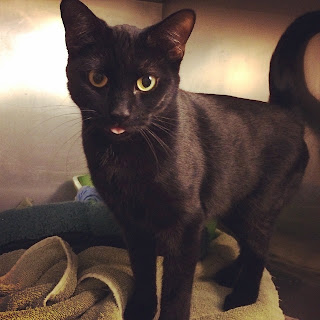Reader Question: How Contagious is Feline Leukemia Virus (FeLV)?
 |
| Mona Lisa, a sweet rescue kitten with FeLV. |
Originally published in Cat Fancy Magazine, October 2014
Question:
I recently took in a very sweet feral kitty and discovered that she tested positive for feline leukemia upon a blood test in March. I was told that if she retests negative, she is free and clear. Does that mean she will no longer be able to transmit the disease to the healthy cat that is already living with me? I have not been able to find any information to confirm what I have been told.
Thank you so much,
Diane B.
Answer:
Diane,
You’ve asked a straight-forward question, but I’m afraid I’m going to have to give you a complicated answer. Because the prevalence of feline leukemia virus (FeLV) infection is low in the general feline population, a negative test is likely to be truly negative. Cats that test positive, however, should have the test repeated and the results confirmed. The fact that your cat is a feral cat makes the positive test much more likely to be a true positive, since feral cats are at the highest risk for contracting FeLV. If your cat tests negative upon retesting, then it is possible that the first test was a false positive. Still, the situation is not a simple one.
Once a cat is exposed to the leukemia virus, one of four general scenarios can occur:
• Progressive infection – the immune system fails to contain the virus. The virus reproduces itself in the body, and many tissues become infected, including the salivary glands. Many virus particles are shed in the saliva. These cats frequently succumb to a FeLV-associated illness in a few months or years. Because the virus is present in the saliva, they are contagious to other cats.
• Regressive infection – the cat mounts an effective immune response. The infection is contained. Viral particles or viral proteins cannot be detected using the common screening tests, however, viral DNA can be detected in the body using a special assay, called PCR (polymerase chain reaction) testing. These cats are at little risk of developing FeLV-associated diseases.
• Abortive exposure – after exposure, the cat mounts an effective immune response, and the virus is presumably eliminated from the body. Virus particles or proteins cannot be detected by any test currently employed.
• Focal infection – a rare scenario, in which the FeLV infection is restricted to certain tissues, such as the spleen, or a lymph node, or a mammary gland.
There is some controversy regarding the four outcomes of FeLV infection described above. In the past, many cats were believed to be able to completely clear the virus from their body – a scenario that fits most closely with “abortive exposure”. I know that this is the scenario you’re hoping for, however, newer research suggests that most cats actually remain infected for life following exposure to the virus. These cats test negative on the common screening tests, and virus particles cannot be cultured from the tissues. However, a specialized DNA test – known as PCR testing – confirms the presence of viral DNA integrated into the cat’s genome. These cats are unlikely to ever completely clear the virus, since the viral DNA has now integrated itself into the cat’s own DNA. These cats are unlikely to shed virus particles in their saliva, and are unlikely to develop FeLV-associated diseases. The clinical significance of these cats that test negative on the screening tests, but test positive on PCR tests, is not yet clear.
I recommend that the initial test that was performed on your cat be repeated in 30 days. Alternatively, a different type of test test can be performed that looks for the virus within infected blood cells. This test, performed on blood smears or on a bone marrow sample, is known as an IFA (immunofluorescence) test. A positive IFA test not only confirms that the cat is infected with FeLV, but that the cat’s bone marrow has been affected – a progressive infection. Sadly, as we noted above, these cats are likely to succumb to a FeLV-associated illness sometime in the future. While waiting to retest your cat, you should not let your other cats be exposed to her. She should be isolated, with her own separate food bowl, water bowl and litter box. If she tests negative on her subsequent retest, it can be difficult to say whether the first test was simply a false positive, i.e. the test was wrong and there was no infection at all, or whether there was true exposure, but your cat truly defeated the virus (“abortive exposure”), or whether your cat has a “regressive infection”, i.e. the viral DNA was incorporated into your cat’s DNA. Cats with regressive infections are believed to not be contagious to other cats, and they don’t usually develop FeLV-related illness. You can have your vet run a FeLV PCR test to find out for sure, if you like. If she tests positive on the retest, then she is truly infected, and I would not recommend keeping her, as the risk of her transmitting the virus to your cat is significant.
Comments
Post a Comment